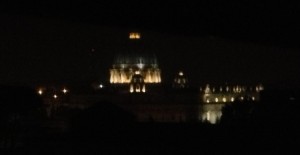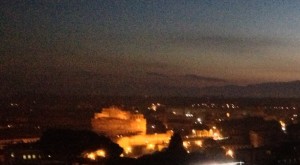Wednesday, October 10, 2012
It is 5:30 a.m. here in Rome, and I am about to start my holy hour before morning Mass. In the picture, you see the lighted dome of St. Peter’s Basilica as it appears in the pre-dawn morning, glimmering in the darkness.
Lumen Gentium is the title given to Vatican II’sDogmatic Constitution on the Church. The story is told that Blessed John XXIII pointed to a globe of the earth and announced “lumen gentium,” meaning that Christ Jesus is the “light to the nations.” The Church, of course, has as her primary mission to proclaim Christ to the nations, and that shimmering dome of St. Peter’s, all lighted in the darkness, speaks to that great mission. The Church serves Christ Jesus and indeed is the mystici corporis, the Mystical Body of Christ, of which the Lord Jesus is the head and we are members.
Recently, I saw among choices for the cover of Christmas cards the dark scene of the magi camped a distance from Bethlehem, where the star was lighting the manger scene. The subtitle was something like “Searchers for the Truth.”
Yesterday, I read about a study conducted by the Pew Forum on Religion and Public Life that reported a rise in the percentage (from 15% to 20%) of the “nones.” Nones are those who claim no religious faith; I believe that the response checked most frequently was “no particular religion.” It has been observed that our culture makes it a bit easier to take this position publicly, but I suspect there are searchers for the truth among this group. In fact, last October, Pope Benedict invited some representatives of this group to Assisi when world religion leaders gathered in dialogue. Yesterday at the Synod, I heard again about the “Courtyard of the Gentiles” being promoted as a means of outreach to searchers with no religious affiliation.
I have been thinking about two ways to contribute to this outreach. The first was suggested to me when I met in focus groups with about 40 young adults a few Sundays ago at Holy Spirit Church in Louisville. A number of these 20-something adults reminded me not to fear inviting them to Christ and to the fullness of Church teaching. One said it clearly: “We are listening and want to hear.” My prayer is that those of us attending this blessed synod will be reminded of this desire to hear and to be both bold and loving in our recommendations to our Holy Father for the new evangelization.
The other way is a follow up of my intervention yesterday at the synod, the summary of which appears in the Vatican daily bulletins. I called for a generous use of the “Blessing of the Child in the Womb,” so recently approved for use in the United States and which I pray will be extended soon to the universal Church. Expressing how this blessing allows the Church to “warmly extend the love of Christ to families as they prepare for the birth of their child,” I hailed this sacred gesture as a way to announce to society the great gift of human life, as well as a gracious invitation for parents to begin preparing for the baptism of their child, once born.
While the text of my intervention is now the property of the synod and so will be used as those in charge would direct, I can share one thought that I frequently spoke about in Louisville and that emerged from another study from the Center for Applied Research in the Apostolate (CARA). This study revealed that nearly 80% of Catholics spoke of being proud to be Catholic. While, sadly, the presence at Sunday Eucharist falls well short of this percentage, this expression of pride reveals a strength and openness upon which to build.
Another local study, done of parents of Catholic school students in Louisville, revealed a resounding wish among parents to “do what is best for their child” – a sentiment that is deeply felt by so many at the time of the birth of their child. Thus, when I presented this “Blessing of the Child in the Womb” to the lay faithful, it was received very well, and most were very positive about the opportunity to invite expectant families to take part. Indeed, preparing for the birth of a child is a time for hope and excitement as well as natural concerns and anxieties, a time that provides a rich opportunity for support and prayers.
I pray that our work in the Synod will concentrate on reaching out and not simply waiting for these silent searchers to come to Christ, the “light for the nations.”
Today, we meet for the first time in small groups divided according to language. I look forward to a full day. Tomorrow our Holy Father will initiate the “Year of Faith” at a special Mass that also celebrates the 50th anniversary of the opening of the Second Vatican Council and the 20th anniversary of the publication of theCatechism of the Catholic Church. I was pleased to learn that the synod delegates are invited to concelebrate this outdoor Mass in St. Peter’s Square, and of course, I will carry your prayer intentions to the Mass.
Monday, October 8, 2012:
This Synod on the New Evangelization is a “new song” to the world from the Church, which is announcing anew Christ, who is the same yesterday, today, and forever.
This morning, this theme of a new song struck me while praying the Office of Readings before Mass.
The beautiful prayer after Psalm 96 captures so eloquently the grace of Jesus Christ as the One who is guiding the synod. “Your Church throughout the world sings you a new song, announcing your wonders to all. Through a Virgin you have brought forth a new birth in our world; through your miracles, a new power; through your suffering, a new patience; in your resurrection, a new hope; and in your ascension, new majesty.” Yes, I thought, the synod is meant to be a “new song” in which Jesus Christ is to be the center.
In an article on my participation in the synod that appeared today in Louisville’s local paper, which nicely expressed the major themes of the synod, I read that a national commentator expressed the fear that the synod would be simply “…the Catechism of the Catholic Church with a smile.” While at first I dismissed this comment as a bit cynical, the comment came to me in prayer this morning and then again during the sessions of the synod.
If not for Christ, the new evangelization would simply be a human activity and indeed susceptible to a distant and shallow smile, with no change. However, with Christ, the same yesterday, today, and forever (Hebrews), the truth of Christ is proclaimed, but in a way that calls us to a deep smile that flows from the joy of His revelation. The smile comes within the joys and sufferings, the grief and anguish of a world thirsting for this eternal and unchanging Word. Thus, the Church proclaims the good news so beautifully captured in the Catechism of the Catholic Church, but one in which Christ calls us to extend His loving invitation.
It has been said that the Vatican Council II was truly a missionary council — not so much an effort to modernize the Church in the sense of conforming to the world, but rather in seeking a new language and spirit to convey a truth that is ever-inviting. It is that truth of Jesus Christ contained in the psalm prayer above.
At the synod session this morning, our Holy Father spoke beautifully of the confession or profession of that good news and the charity through which that Good News is expressed. His words, along with so many key interventions of the synod, are being reported quickly in the Vatican daily bulletins that will find their way into Catholic news sources. We also heard witnesses of bishops from all five continents, expressing both shared and unique cultural blessings and challenges.
Two images that flashed on the screen in the synod hall were the Annunciation (Mary hearing from the Angel Gabriel about the Word Made Flesh) and the Good Shepherd from the Priscilla Catacombs, providing an ancient and vivid portrait of the loving Jesus seeking out the lost.
Indeed, the Synod calls for a new song and a smile of Christ to the world. This is not a distant and shallow expression, but a deep smile that reflects the joy of God and through which the Lord Jesus seeks those who are lost and draw those searching to Himself.
Sitting in the sixth row, I found myself very close to the speakers and quite absorbed in the presentations. The content will be distributed through the Vatican News Office, but what may not come through the official channels is the effect on my heart and, I suspect, of so many delegates. It is simultaneously overwhelming and intriguing to experience the rich tapestry of voices from every corner of the world. I recall the quote from Cardinal George, who speaks of the Church’s primary task: “…to introduce Christ to the world in every generation.”
We heard witnesses of struggles with religious liberty, no stranger to the United States these days, from so many parts of our world. It reinforced the importance of our commitment to be courageous announcers of the good news of Jesus Christ as well as good citizens, who propose values that can shape the culture in which we live and that will advance the common good.
I also continue to meet more and more delegates and auditors. It was a nice surprise to receive a letter, delivered by Cardinal Napier of South Africa, from Fr. Frank Doyle, an Augustinian priest. During my days in Knoxville, Fr. Doyle was stationed at a retreat house in western North Carolina and became my confessor and friend. He left for South Africa about six years ago. It was great to get his letter and be reminded of his work with those who are orphaned and in great need. It is a small world!
Please continue your prayers as I bring the intentions of the faithful of the Archdiocese of Louisville with me to Mass and daily prayers. Thursday is a special day. Our Holy Father celebrates Mass for the opening of the Year of Faith and the 50th anniversary of the opening session of the Vatican Council II.



No comments:
Post a Comment